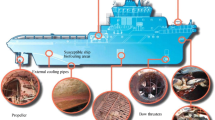Abstract
The scheme of an electric installation of an unmanned underwater vehicle based on a chemical current source of aluminum–water type with an alkaline electrolyte is considered. The mass–volume and energy characteristics of energy sources based on the aluminum–water system with an alkaline electrolyte and the characteristics of the main and auxiliary batteries of energy sources are given. It is shown that, in terms of stored energy, installations with chemical current sources of the aluminum–oxygen system are equivalent to installations with aluminum–water current sources in an alkaline electrolyte and have about six times more energy than an SP-200 battery and twice as much as installations with magnesium–seawater current sources. The given characteristics of power plants show that hydronic chemical current sources based on aluminum are promising and have competitive indicators, but require the development of the production of appropriate materials for electrodes.



Similar content being viewed by others
REFERENCES
Smith, S.M. and Dunn, S.E., The Ocean Voyager II: an AUV designed for coastal oceanography, Proc. IEEE Symp. on Autonomous Underwater Vehicle Technology (AUV’94), Cambridge, MA, 1994.
Zeng, Y., Zhang, R., and Lim, T.J., Throughput maximization for UAV-enabled mobile relaying systems, IEEE Trans. Commun., 2016, vol. 64, no. 12.
Zhilenkov, A.A., Detailed control of cleaner chemical production of semiconductor devices with a cleaner structure, Trudy Mezhdunarodnoi nauchnoi konferentsii “Energo-resursoeffektivnost’ v interesakh ustoichivogo razvitiya” (Proc. Int. Sci. Conf. “Energy and Resource Efficiency for Sustainable Development”), Tomsk: Nats. Issled. Tomsk. Politekh. Univ., 2018.
Gilyazov, D.D., Zhilenkov, A.A., Matveev, I.I., and Krishtal, Y.V., Power line communication technologies in automated control systems, Proc. IEEE Conf. of Russian Young Researchers in Electrical and Electronic Engineering (EIConRus), St. Petersburg, 2017.
Ku, M.-L., Li, W., Chen, Y., and Ray Liu, K.J., Advances in energy harvesting communications: past, present, and future challenges, IEEE Commun. Surv. Tutorials, 2016, vol. 18, no. 2.
Zhilenkov, A.A. and Efremov, A.A., A quality evaluation of stabilization of rotation frequency of gas-diesel engines when using an adaptive automatic control system, IOP Conf. Ser.: Mater. Sci. Eng., 2017, vol. 177, art. ID 012043.
Funding
This work was supported by the Ministry of Education and Science of Russia within the framework of the program of a World Class Research Center in the field “Leading Digital Technologies” of St. Petersburg State Marine Technical University, agreement no. 075-15-2020-903 of November 16, 2020.
Author information
Authors and Affiliations
Corresponding author
Additional information
Translated by A. Muravev
About this article
Cite this article
Novikov, A.V., Zhilenkov, A.A., Markovkina, N.N. et al. Problems and Ways of Creating Efficient Electric Power Installations for Unmanned Underwater Vehicles Based on Chemical Current Sources. Russ. Electr. Engin. 92, 262–267 (2021). https://doi.org/10.3103/S1068371221050084
Received:
Revised:
Accepted:
Published:
Issue Date:
DOI: https://doi.org/10.3103/S1068371221050084




